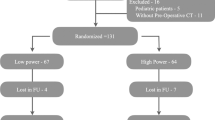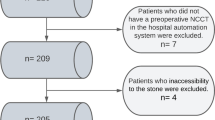Abstract
Purpose
To compare the clinical efficacy and safety between the FURL with 365 μm and 200 μm holmium laser for treating nephrolithiasis.
Materials and methods
A prospective randomized controlled trial was performed including analysis of data from 200 patients with nephrolithiasis. A total of 180 patients were randomized into two groups according to 1:1 ratio. In the 365 μm holmium laser group, kidney stones were disintegrated into less than 2 mm fragments with a 365 µm holmium laser fiber with the settings of 30–45 W under direct visualization; in the control group, the conventional 200 μm holmium laser was used. Descriptive statistics and logistic regression analyses tested the association among operation time, stone-free rate (SFR) and incidence of complications.
Results
Operation time in the FURL with 365 μm laser was significantly shortened and no significance was observed in the complication rate. Stone size and location were identified as two major confounding factors for the operation time and SFR. Moreover, the FURL using 365 μm laser showed less operation time for renal stones with the diameter between 1 and 2 cm, stones located in lower calyx and multiple calculi; stones larger than 2 cm and/or located in lower pole inclined to present better SFR using the FURL with 365 μm laser.
Conclusions
The FURL combined with 365 μm holmium laser is safer and highly efficacious for the management of nephrolithiasis when compared to conventional FURL procedures, especially for those located in lower pole and larger than 2 cm.

Similar content being viewed by others
References
Turk C, Petrik A, Sarica K, Seitz C, Skolarikos A, Straub M et al (2016) EAU guidelines on interventional treatment for urolithiasis. Eur Urol 69(3):475–482
Kirac M, Bozkurt OF, Tunc L, Guneri C, Unsal A, Biri H (2013) Comparison of retrograde intrarenal surgery and mini-percutaneous nephrolithotomy in management of lower-pole renal stones with a diameter of smaller than 15 mm. Urolithiasis 41(3):241–246
Assimos D, Krambeck A, Miller NL, Monga M, Murad MH, Nelson CP et al (2016) Surgical management of stones: American urological association/endourological society guideline. Part I. J Urol 196(4):1153–1160
Desai J, Zeng G, Zhao Z, Zhong W, Chen W, Wu W (2013) A novel technique of ultra-mini-percutaneous nephrolithotomy: introduction and an initial experience for treatment of upper urinary calculi less than 2 cm. Biomed Res Int 2013:490793
Turk C (2016) Urolithiasis guidelines: retrospective view and perspectives. UrolA. 55(10):1317–1320
Preminger GM, Assimos DG, Lingeman JE, Nakada SY, Pearle MS, Wolf JS et al (2005) Chapter 1: AUA guideline on management of staghorn calculi: diagnosis and treatment recommendations. J Urol 173(6):1991–2000
Khemees TA, Shore DM, Antiporda M, Teichman JM, Knudsen BE (2013) Evaluation of a new 240-µm single-use holmium:YAG optical fiber for flexible ureteroscopy. J Endourol Endourol Soc 27(4):475–479
Resorlu B, Oguz U, Resorlu EB, Oztuna D, Unsal A (2012) The impact of pelvicaliceal anatomy on the success of retrograde intrarenal surgery in patients with lower pole renal stones. Urology 79(1):61–66
Moher D, Hopewell S, Schulz KF, Montori V, Gotzsche PC, Devereaux PJ et al (2010) CONSORT 2010 explanation and elaboration: updated guidelines for reporting parallel group randomised trials. J Clin Epidemiol 63(8):e1–e37
Fernbach SK, Maizels M, Conway JJ (1993) Ultrasound grading of hydronephrosis: introduction to the system used by the Society for Fetal Urology. Pediatr Radiol 23(6):478–480
Ghani KR, Wolf JS Jr (2015) What is the stone-free rate following flexible ureteroscopy for kidney stones? Nat Rev Urol 12(5):281–288
Dauw CA, Simeon L, Alruwaily AF, Sanguedolce F, Hollingsworth JM, Roberts WW et al (2015) Contemporary practice patterns of flexible ureteroscopy for treating renal stones: results of a Worldwide Survey. J Endourol Endourol Soc 29(11):1221–1230
Huang Z, Fu F, Zhong Z, Zhang L, Xu R, Zhao X (2012) Flexible ureteroscopy and laser lithotripsy for bilateral multiple intrarenal stones: is this a valuable choice? Urology 80(4):800–804
Bariani GM, de Celis Ferrari AC, Precivale M, Arai R, Saad ED, Riechelmann RP (2015) Sample size calculation in oncology trials: quality of reporting and implications for clinical cancer research. Am J Clin Oncol 38(6):570–574
Baghdadi M, Emiliani E, Talso M, Servian P, Barreiro A, Orosa A et al (2017) Comparison of laser fiber passage in ureteroscopic maximum deflection and their influence on deflection and irrigation: do we really need the ball tip concept? World J Urol 35(2):313–318
Vassar GJ, Teichman JM, Glickman RD (1998) Holmium: YAG lithotripsy efficiency varies with energy density. J Urol 160(2):471–476
Spore SS, Teichman JM, Corbin NS, Champion PC, Williamson EA, Glickman RD (1999) Holmium: YAG lithotripsy: optimal power settings. J Endourol Endourol Soc 13(8):559–566
Hu H, Lu Y, He D, Cui L, Zhang J, Zhao Z et al (2016) Comparison of minimally invasive percutaneous nephrolithotomy and flexible ureteroscopy for the treatment of intermediate proximal ureteral and renal stones in the elderly. Urolithiasis 44(5):427–434
Yang J, Tao RZ, Lu P, Chen MX, Huang XK, Chen KL et al (2018) Efficacy analysis of self-help position therapy after holmium laser lithotripsy via flexible ureteroscopy. BMC Urol 18(1):33
Acknowledgements
This work was supported by the National Natural Science Foundation of China (Grant Numbers 81570676), the Science and Education Health Project of Jiangsu Province for Important Talent (Grant Number RC2011055), the “333 High Level Talents Project” in Jiangsu Province, China (Grant Numbers BRA2017532, BRA2015469), the Standardized Diagnosis and Treatment Research Program of Key Diseases in Jiangsu Province, China (Grant Number BE2016791), the Open Project Program of Health Department of Jiangsu Province, China (Grant Number JSY-2-2016-099), the Jiangsu Province Six Talents Peak from Department of Human Resources, Social Security Office of Jiangsu Province, China (Grant Numbers 2010WSN-56), the General Program of Health Department of Jiangsu Province, China (Grant Number H2009907), and the Priority Academic Program Development of Jiangsu Higher Education Institutions (Grant Number JX10231801).
Author information
Authors and Affiliations
Contributions
PL: Protocol development and data management; KC: Data collection and management; ZW: Data analysis and manuscript writing; RS: Data analysis; JZ: Data management; BL: Data collection; GZ: Data collection and protocol development; ZW: Data management and funding; WZ: Protocol development and manuscript writing; MG: Protocol development and funding.
Corresponding authors
Ethics declarations
Conflict of interest
The authors declare that they have no competing financial interests.
Research involving human participants and/or animals
The protocols followed in this study were in accordance with the ethical standards of the Declarations of Helsinki and Istanbul, and approved by the local ethics committee of the First Affiliated Hospital of Nanjing Medical University (2017-SR-196).
Informed consent
Written informed consents from all enrolled patients were obtained. The selection of operation ways strictly conformed to the diagnosis and treatment guideline of urology and obtained the consent and recognition of the patients.
Additional information
Publisher's Note
Springer Nature remains neutral with regard to jurisdictional claims in published maps and institutional affiliations.
Rights and permissions
About this article
Cite this article
Lu, P., Chen, K., Wang, Z. et al. Clinical efficacy and safety of flexible ureteroscopic lithotripsy using 365 μm holmium laser for nephrolithiasis: a prospective, randomized, controlled trial. World J Urol 38, 481–487 (2020). https://doi.org/10.1007/s00345-019-02776-w
Received:
Accepted:
Published:
Issue Date:
DOI: https://doi.org/10.1007/s00345-019-02776-w




